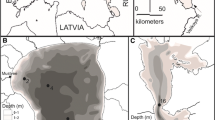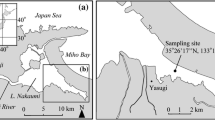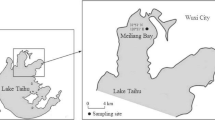Abstract
Wind-induced sediment resuspension occurs frequently in the shallow and eutrophic Lake Arresø, Denmark. The impact of resuspension on internal phosphorus loading was investigated by laboratory experiments studying P-release from the undisturbed sediment surface and by experiments simulating resuspension events.
Phosphorus release from undisturbed sediment sampled in May and August was 12 mg and 4 mg m−2 d−1, respectively. During experimental simulation of resuspension, soluble reactive phosphate (SRP) increased by 20–80 µg l−1, which indicates that a typical resuspension event in the lake would be accompanied by the release of 150 mg SRP m−2. The internal P loading induced by resuspension is estimated to be 60–70 mg m−2 d−1, or 20–30 times greater than the release from undisturbed sediment.
SRP release during simulation of resuspension was mainly dependent on the equilibrium conditions in the water column and was basically independent of the increase in suspended solids and the duration of resuspension. A second simulation of resuspension conducted 26 hours later, did not result in any further release of SRP from sediment sampled in May. In contrast, there was an additional SRP release from sediment sampled in August, indicating that an exchangable P pool, capable of altering equilibrium conditions, is built up between resuspension events.
It is concluded that resuspension, by increasing the P flux between sediment and water, plays a major role in the maintenance of the high nutrient level in Lake Arresø. A relatively high release rate is maintained during resuspension because of the low Fe:P ratio and the high concentration of NH4Cl-extractable P in the sediment.
Similar content being viewed by others
References
Aalderink, R. H., L. Lijklema, J. Breukelman, W. Raaphorts & A. G. Brinkman, 1984. Quantification of wind-induced resuspension in a shallow lake. Wat. sci. Tech. 17: 903–914.
Andersen, J. M., 1974. Nitrogen and phosphorus budgets and the role of sediments in six shallow Danish lakes. Arch. Hydrobiol. 74: 528–550.
Andersen, F. Ø. & E. Lastein, 1981. Sedimentation of resuspension in shallow eutrophic Lake Arreskov, Denmark. Verh. int. Ver. Limnol. 21: 425–430.
APHA, 1980. Standard Methods For the Examination of Water and Wastewater.
Bengtsson, L., T. Hellström & L. Rakoczi, 1990. Redistribution of sediments in three Swedish lakes. Hydrobiologia 192: 167–181.
Bonnie, K. E. & J. A. Standford, 1988. Phosphorus bioavailability of fluvial sediments determined by algal assays. Hydrobiologia 160: 9–18.
Boström, B., M. Jansson & C. Forsberg, 1982. Phosphorus release from lake sediments. Arch. Hydrobiol. Beih. Ergebn. Limnol. 18: 5–59.
de Groot, W. T., 1981. Phosphate and wind in a shallow lake.Arch. Hydrobiol. 91: 475–489.
Demers, S., J.-C. Therrialut, E. Bourget & B. Bah, 1987. Resuspension in the shallow sublittoral zone of a macrotidal estuarine environment: Wind influence. Limnol. Oceanogr. 32: 327–339.
Enell, M. & S. Löfgren, 1988. Phosphorus in interstitial water: methods and dynamics. Hydrobiologia 170: 103–132.
Gippel, C. L.,1989. The use of turbidimeters in suspended research.Hydrobiologia 176/177: 465–480.
Hamilton, D. P. & S. F. Mitchell, 1988. Effects of wind on nitrogen, phosphorus, and chlorophyll in a shallow New Zealand lake.Verh. int. Ver. Limnol. 23: 624–628.
Hieltjes, A. H. M. & L. Lijklema, 1980. Fractionation of Inorganic Phosphates in Calcareous Sediments. J. envir. Qual. 9: 405–407.
Holtan, H., L. Kamp-Nielsen & A. O. Stuanes, 1988. Phosphorus in soil, water and sediment: an overview. Hydrobiologia 170: 19–34.
Hovedstadsrådet, 1989a. Restaurering og fremtidig tilstand i Arresø (in Danish).
Hovedstadsrådet, 1989b. Arresø 1985–1988, Tilsynsdata. (in Danish).
Jensen, H. S., P. Kristensen, E. Jeppesen & A. Skytthe (in pres). Iron:phosphorus ratio in surface sediment as an indicator of phosphate release from aerobic sediments in shallow lakes. Presented on the 5th International Symposium on The Interactions between Sediments and Water, Sweden August 1990.
Jonasson, P. M. & C. Lindegård, 1979. Zoobenthos and its contribution to the metabolism of shallow lakes. Arch. Hydrobiol. Beih. Ergebn. Limnol. 13: 162–180.
Koroleff, F., 1970. Determination of total phosphorus in natural water by means of persulphate oxidation. An. Interlab. report No. 3 Cons. Int. pour l'Explor de la mer.
Kristensen, P., M. Søndergaard & E. Jeppesen, 1992. Resuspension in a shallow lake. Presented at the 5th International Symposium on The Interactions between Sediments and Water, Sweden, August 1990. Hydrobiologia 228: 101–109.
Kristensen, P., J. P. Jensen & E. Jeppesen, in press. Simple empirical lake models.
Murphy, J. & J. P. Riley, 1962. A modified single solution method for determination of phosphate in natural waters. Anal. Chem. Acta 27: 31–36.
Olrik, K., 1981. Succession of Phytoplankton in Response to Environmental Factors in Lake Arresø, North Zealand, Denmark. Schweiz. Z. Hydrol. 43: 6–19.
Peters, R. H. & A. Cattaneo, 1984. The effects of turbulence on phosphorus supply in a shallow bay of Lake Memphremagog.Verh. int. Ver. Limnol. 22: 185–189.
Reynolds, C., 1984. The ecology of freshwater phytoplankton. Cambridge University press, 384 pp.
Reynolds, C. S., 1987. Cyanobacterial Water-Bloms. Adv. Both. Res. 13: 67–143.
Ryding, S.-O. & C. Forsberg, 1977. Sediments as a nutrient source in shallow polluted lakes. In: Golterman, H. L. (ed.), Interactions between sediments and fresh water: 227–234. Dr W. Junk B. V., The Hague.
Sommer, U., 1989. Plankton ecology. Springer Verlag, 369 pp.
Søndergaard, M., 1989. Phosphorus release from a hypertrophic lake sediment: Experiments with intact sediment cores in a continuous flow system. Arch. Hydrobiol. 116: 45–59.
Søndergaard,M., 1990. Pore water dynamics in the sediment of a shallow and hypertrophic lake 1990. Hydrobiologia 192:247–258.
Viner, A. B., 1988. Phosphorus on suspensoids from the Tongariro River (North Island, New Zealand) and its potential availability for algal growth. Arch. Hydrobiol. 111: 481–489.
Author information
Authors and Affiliations
Rights and permissions
About this article
Cite this article
Søndergaard, M., Kristensen, P. & Jeppesen, E. Phosphorus release from resuspended sediment in the shallow and wind-exposed Lake Arresø, Denmark. Hydrobiologia 228, 91–99 (1992). https://doi.org/10.1007/BF00006480
Issue Date:
DOI: https://doi.org/10.1007/BF00006480




